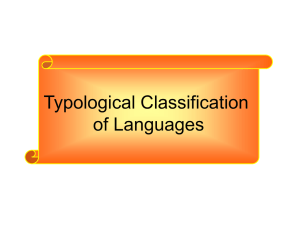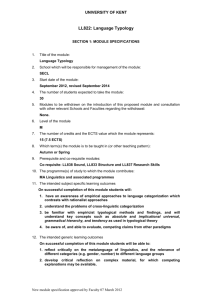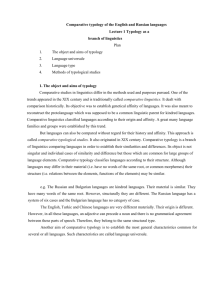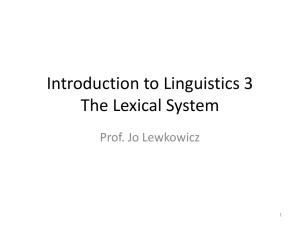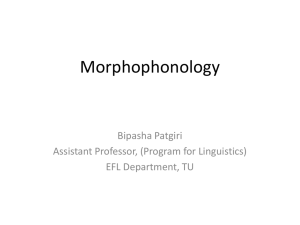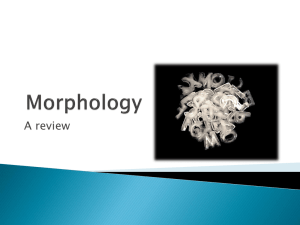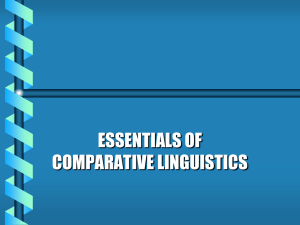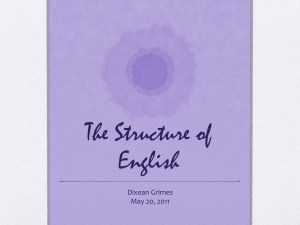Language Typology: Classifications & Examples
advertisement
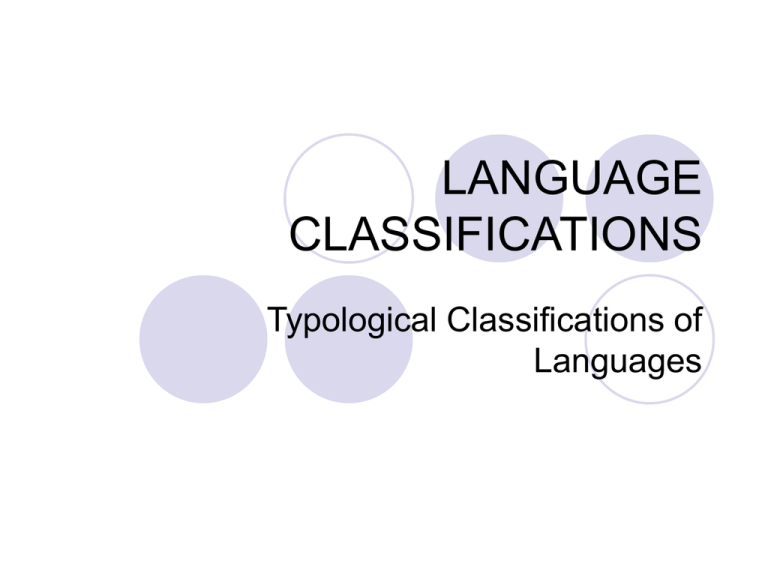
LANGUAGE CLASSIFICATIONS Typological Classifications of Languages Language classifications Genetic Typological Sanskrit Мāтар Відгава Свасар Мус Вāюс Гірі Нава дваӮ Траяс Панча - - - - Ukrainian матір - - mother widow sister mouse вітер гора новий два три пять - wind hill new two three five вдова сестра миша English Language classifications Genetic Typological Languages share linguistic properties because they’re genetically related, historically, they evolved from the same parent language. Typological classifications are based on shared formal characteristics of languages, irrespective of their origin: properties of sounds, words, sentences. Historical Comparative Linguistics Linguistic Typology Typological classifications English (Germanic), Classical Arabic (Semitic), Russian (Slavic), form wh-questions by placing the wh-phrase at the front of the sentence (called wh-fronting): Who did you meet? What did he do? By contrast, Chinese, Japanese, and Egyptian Arabic form wh-questions by leaving the wh-phrase in the end: You met who? He did what? Typological classifications Frederick Schlegel (1772-1829) August Schlegel ( 1767-1845) Wilhelm Humboldt (1767-1835) Typological classifications Morphological Syntactic Phonological Morphological Classification Isolating languages Agglutinating languages Flectional languages synthetic languages analytic languages Polysynthetic languages Isolating Languages Each word in the sentence consists of just one morpheme: [ wƆ mǝn tan tçin ] [ wƆ mǝn tan tçin lǝ ] [ ta da wƆ mǝn ] Agglutinating Languages Each morpheme expresses only one meaning element. The breaks between morphemes (e.g. between root and affix) are usually easy to identify. Agglutinating Languages Turkish ev house el ev-im my house ev-e to a house ev-in of a house ev-de in a house ev-imiz our house ev-ler houses ev-ĵik-ler little houses ev-ler-de , ev-ler-imiz-e N-A-pl-pron-prep of our little hands el-ĵik- ler -imiz -in - hand Agglutinating Languages Swahili Present ni-na-soma u-na-soma a-na-soma Past ni-li-soma Future ni-ta-soma Flectional (Fusional) each affixal morpheme expresses more than one meaning morphemes are frequently fused together (root morphemes are affected by affixal morphemes) Ukr.: чита-є чита-в пис-ав пиш-е несу носив Greek: lu-o ‘I loose’ lu-ousin ‘They loose’ Flectional languages Synthetic (читає, читають, читав, України, Петро бачив Анну) Analytic (is reading, are reading, was reading, capital of Ukraine, Peter saw Ann) Polysynthetic (Incorporating) These languages typically combine many morphemes to form very long words. qasu-iir-sar-vig-ssar-si-ngit-luinar-nar-puq ‘Someone did not find a completely suitable resting place.’ Historically, synthetic morphology is usually derived from agglutinative morphology, which in turn is derived from the analytic use of function words: isolating→analytic→agglutinating →synthetic Hence, different languages usually possess features of different morphological types Agglutination features in English Сomerse Comersial, comersialism,comercialist(ic) establish establish-ment establish-ment-ary establish-ment-ari-an establish-ment-ari-an-ism dis-establish-ment-ari-an-ism anti-dis-establish-ment-ari-an-ism Synthetic features in English write study study good wife - wrote studied studies better wives - written Analytic features in English Come- are coming Take – will take Does – is done Get – have got Difficult – more difficult A book - the book Polysynthetic features in English a devil-may-care attitude a merry-go-round The type of language is established on the basis of its predominant features. Isolating__E_____________U______Polysynthetic REVISION What is the difference of genetic and typological classification of languages? What is the type of language based on? Which language type construct words from clearly defined morphemes? In which language type affixes are not easy to separate from the stem? Which language type has mostly one- morpheme words? Which language type combines many morphemes to form very long words? Are there pure types of languages? Comment on the slide Sanskrit Мāтар Відгава Свасар Мус Вāюс Гірі Нава дваӮ Траяс Панча - - - - Ukrainian матір - - mother widow sister mouse вітер гора новий два три пять - wind hill new two three five вдова сестра миша English d) Mandarin Ta chi fan le he eat meal … Syntactic classifications Basic word orders SVO, SOV, VSO, VOS, OVS, OSV Basic word order types in the world’s languages 1. 2. 3. 4. 5. 6. SOV SVO VSO VOS OVS OSV 45 % 42 % 9% 3% 1% 1% Phonological classifications Vocalic Consonantal Language Abkhaz Italian Ukrainian Georgian English French Finnish Estonian Thai Consonants Vowels 68 35 33 28 24 17 14 24 20 3 7 5 5 20 18 16 27 35 Total 71 42 38 33 44 35 30 51 55 Phonological Classifications tone languages stress languages Tonemes give paradigmatic prominence to a syllable, while stress mainly gives syntagmatic prominence. Tone languages (languages with tonemes) Chinese: ma 1 ma 2 ma 3 ma 4 “mother” “hemp” “horse” “to scold” a high level tone a rising tone a low falling-rising tone a falling tone Stress languages free stress(or unpredictable) fixed stress (or predictable) • last syllable (French, Turkish) • first syllable (Czech, Hungarian, Latvian) • penultimate (second-last) syllable (Polish, Swahili) Home task: Korunets I. p.33 Topics for class discussion Home assignment Find 2 examples typical of each morphological language type in Ukrainian and English
